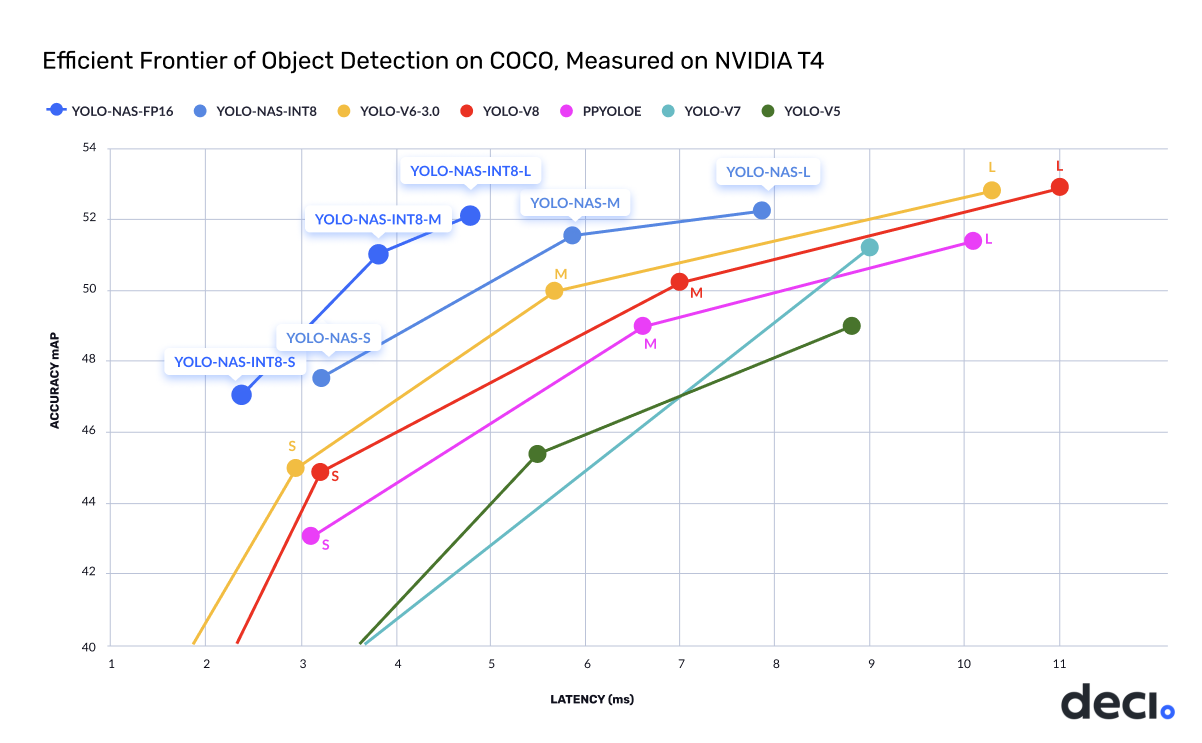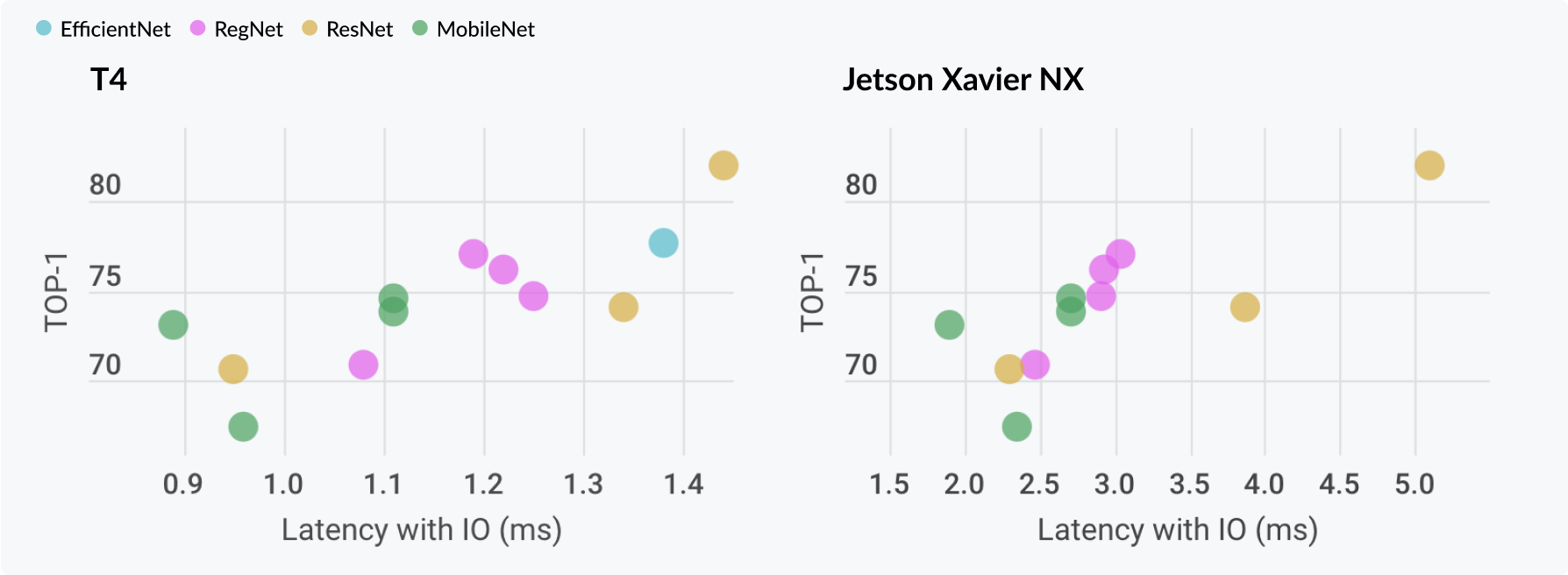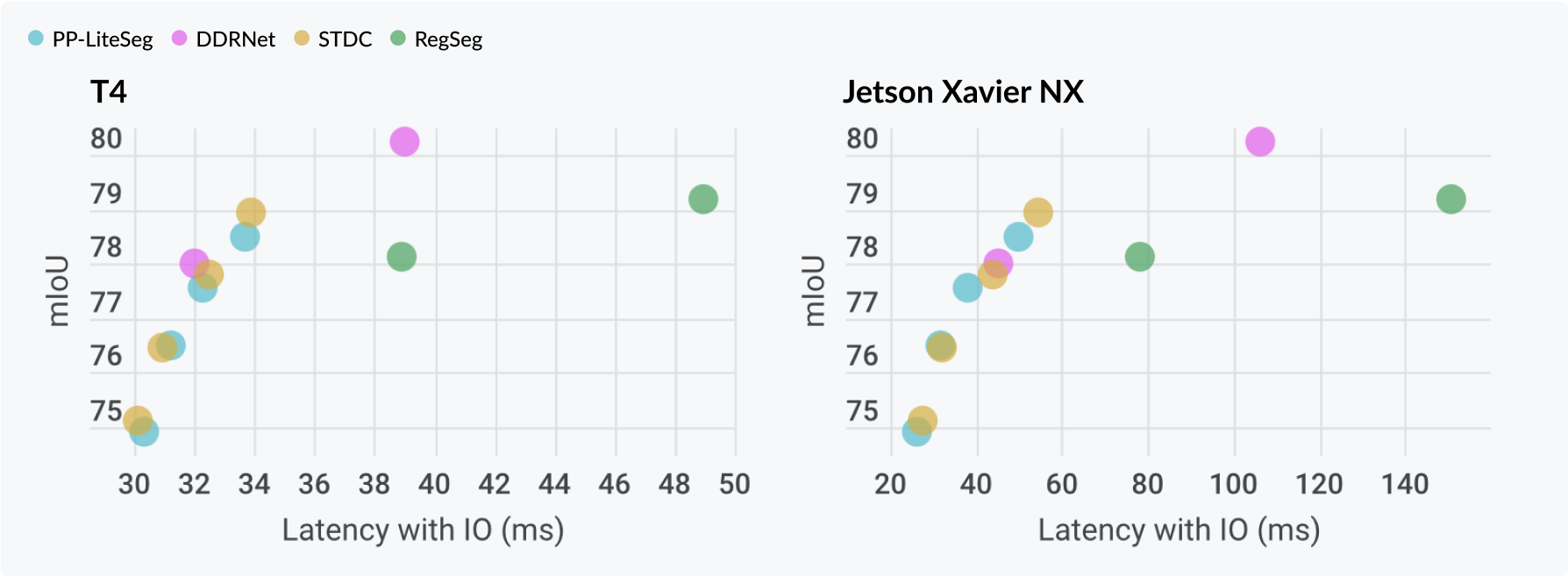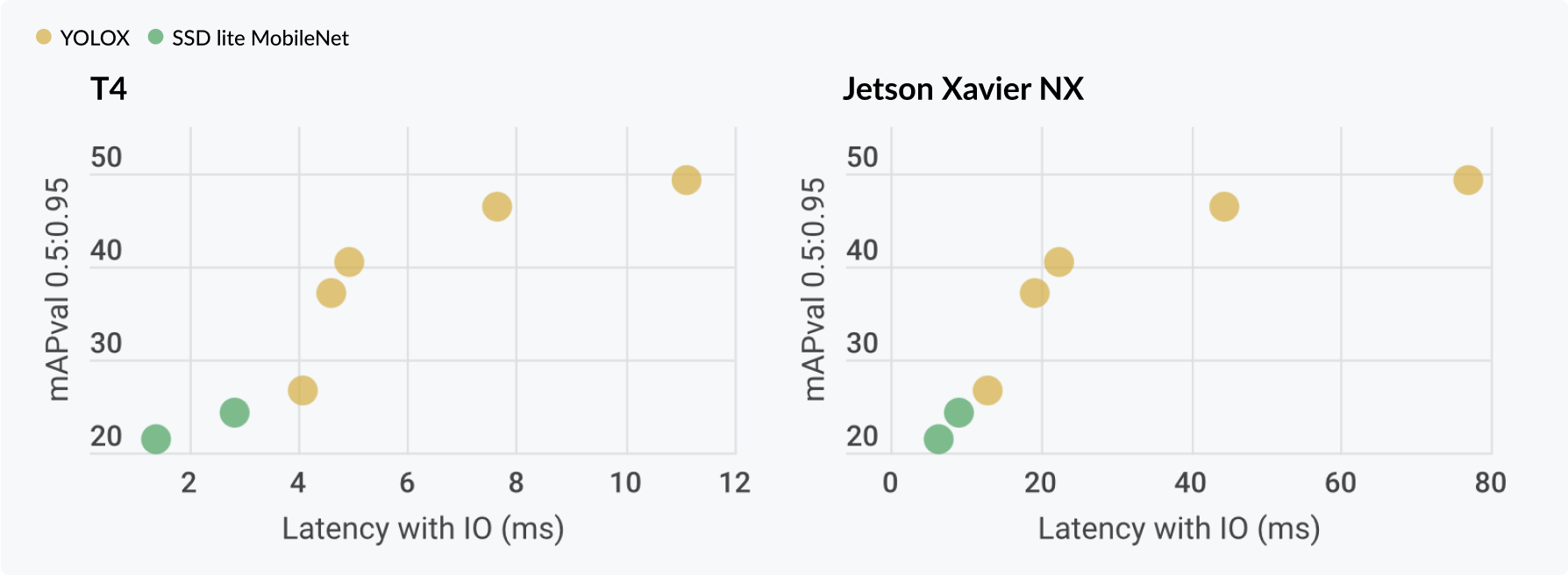Website • Docs • Getting Started • Pretrained Models • Community • License • Deci Platform
YOLO-NAS architecture is out! The new YOLO-NAS delivers state-of-the-art performance with the unparalleled accuracy-speed performance, outperforming other models such as YOLOv5, YOLOv6, YOLOv7 and YOLOv8. Check it out here: YOLO-NAS.
# Load model with pretrained weights
from super_gradients.training import models
from super_gradients.common.object_names import Models
model = models.get(Models.YOLO_NAS_M, pretrained_weights="coco")All Computer Vision Models - Pretrained Checkpoints can be found in the Model Zoo
Easily load and fine-tune production-ready, pre-trained SOTA models that incorporate best practices and validated hyper-parameters for achieving best-in-class accuracy. For more information on how to do it go to Getting Started
python -m super_gradients.train_from_recipe architecture=regnetY800 dataset_interface.data_dir=<YOUR_Imagenet_LOCAL_PATH> ckpt_root_dir=<CHEKPOINT_DIRECTORY>More example on how and why to use recipes can be found in Recipes
All SuperGradients models’ are production ready in the sense that they are compatible with deployment tools such as TensorRT (Nvidia) and OpenVINO (Intel) and can be easily taken into production. With a few lines of code you can easily integrate the models into your codebase.
# Load model with pretrained weights
from super_gradients.training import models
from super_gradients.common.object_names import Models
model = models.get(Models.YOLO_NAS_M, pretrained_weights="coco")
# Prepare model for conversion
# Input size is in format of [Batch x Channels x Width x Height] where 640 is the standard COCO dataset dimensions
model.eval()
model.prep_model_for_conversion(input_size=[1, 3, 640, 640])
# Create dummy_input
# Convert model to onnx
torch.onnx.export(model, dummy_input, "yolo_nas_m.onnx")More information on how to take your model to production can be found in Getting Started notebooks
pip install super-gradients30th of May
Version 3.1.1 (May 3rd)
- YOLO-NAS
- New predict function (predict on any image, video, url, path, stream)
- RoboFlow100 datasets integration
- A new Documentation Hub
- Integration with DagsHub for experiment monitoring
- Support Darknet/Yolo format detection dataset (used by Yolo v5, v6, v7, v8)
- Segformer model and recipe
- Post Training Quantization and Quantization Aware Training - notebooks
Check out SG full release notes.
- Pre-trained pose estimation model
- Test Time Augmentations (TTA)
- Recipe to train DEKR model(convertable to TRT)
- Key-points Rescoring for Pose estimation
- LR finder
- Data analysis tools
- Getting Started
- Advanced Features
- Installation Methods
- Implemented Model Architectures
- Contributing
- Citation
- Community
- License
- Deci Platform
The most simple and straightforward way to start training SOTA performance models with SuperGradients reproducible recipes. Just define your dataset path and where you want your checkpoints to be saved and you are good to go from your terminal!
Just make sure that you setup your dataset according to the data dir specified in the recipe.
python -m super_gradients.train_from_recipe --config-name=imagenet_regnetY architecture=regnetY800 dataset_interface.data_dir=<YOUR_Imagenet_LOCAL_PATH> ckpt_root_dir=<CHEKPOINT_DIRECTORY>Want to try our pre-trained models on your machine? Import SuperGradients, initialize your Trainer, and load your desired architecture and pre-trained weights from our SOTA model zoo
# The pretrained_weights argument will load a pre-trained architecture on the provided dataset
import super_gradients
model = models.get("model-name", pretrained_weights="pretrained-model-name")
 Classification Transfer Learning Classification Transfer Learning
|
 GitHub source GitHub source
|
 Segmentation Quick Start Segmentation Quick Start
|
 Segmentation Transfer Learning Segmentation Transfer Learning
|
 Segmentation How to Connect Custom Dataset Segmentation How to Connect Custom Dataset
|
 Detection Transfer Learning Detection Transfer Learning
|
 Detection How to Connect Custom Dataset Detection How to Connect Custom Dataset
|
 How to Predict Using Pre-trained Model How to Predict Using Pre-trained Model
|
Quantization involves representing weights and biases in lower precision, resulting in reduced memory and computational requirements, making it useful for deploying models on devices with limited resources. The process can be done during training, called Quantization aware training, or after training, called post-training quantization. A full tutorial can be found here.
 Post Training Quantization and Quantization Aware Training Post Training Quantization and Quantization Aware Training
|
This tutorial provides a comprehensive guide on how to fine-tune a YoloNAS model using a custom dataset. It also demonstrates how to utilize SG's QAT (Quantization-Aware Training) support. Additionally, it offers step-by-step instructions on deploying the model and performing benchmarking.
 Quantization Aware Training YoloNAS on Custom Dataset Quantization Aware Training YoloNAS on Custom Dataset
|
Knowledge Distillation is a training technique that uses a large model, teacher model, to improve the performance of a smaller model, the student model. Learn more about SuperGradients knowledge distillation training with our pre-trained BEiT base teacher model and Resnet18 student model on CIFAR10 example notebook on Google Colab for an easy to use tutorial using free GPU hardware
 Knowledge Distillation Training Knowledge Distillation Training
|
To train a model, it is necessary to configure 4 main components. These components are aggregated into a single "main" recipe .yaml file that inherits the aforementioned dataset, architecture, raining and checkpoint params. It is also possible (and recomended for flexibility) to override default settings with custom ones.
All recipes can be found here
Recipes support out of the box every model, metric or loss that is implemented in SuperGradients, but you can easily extend this to any custom object that you need by "registering it". Check out this tutorial for more information.
 How to Use Recipes How to Use Recipes
|
Recent Deep Learning models are growing larger and larger to an extent that training on a single GPU can take weeks. In order to train models in a timely fashion, it is necessary to train them with multiple GPUs. Using 100s GPUs can reduce training time of a model from a week to less than an hour.
Each GPU has its own process, which controls a copy of the model and which loads its own mini-batch from disk and sends it to its GPU during training. After the forward pass is completed on every GPU, the gradient is reduced across all GPUs, yielding to all the GPUs having the same gradient locally. This leads to the model weights to stay synchronized across all GPUs after the backward pass.
You can use SuperGradients to train your model with DDP in just a few lines.
main.py
from super_gradients import init_trainer, Trainer
from super_gradients.common import MultiGPUMode
from super_gradients.training.utils.distributed_training_utils import setup_device
# Initialize the environment
init_trainer()
# Launch DDP on 4 GPUs'
setup_device(multi_gpu=MultiGPUMode.DISTRIBUTED_DATA_PARALLEL, num_gpus=4)
# Call the trainer
Trainer(expriment_name=...)
# Everything you do below will run on 4 gpus
...
Trainer.train(...)Finally, you can launch your distributed training with a simple python call.
python main.pyPlease note that if you work with torch<1.9.0 (deprecated), you will have to launch your training with either
torch.distributed.launch or torchrun, in which case nproc_per_node will overwrite the value set with gpu_mode:
python -m torch.distributed.launch --nproc_per_node=4 main.pytorchrun --nproc_per_node=4 main.pyIt is often in DDP training that we want to execute code on the master rank (i.e rank 0). In SG, users usually execute their own code by triggering "Phase Callbacks" (see "Using phase callbacks" section below). One can make sure the desired code will only be ran on rank 0, using ddp_silent_mode or the multi_process_safe decorator. For example, consider the simple phase callback below, that uploads the first 3 images of every batch during training to the Tensorboard:
from super_gradients.training.utils.callbacks import PhaseCallback, PhaseContext, Phase
from super_gradients.common.environment.env_helpers import multi_process_safe
class Upload3TrainImagesCalbback(PhaseCallback):
def __init__(
self,
):
super().__init__(phase=Phase.TRAIN_BATCH_END)
@multi_process_safe
def __call__(self, context: PhaseContext):
batch_imgs = context.inputs.cpu().detach().numpy()
tag = "batch_" + str(context.batch_idx) + "_images"
context.sg_logger.add_images(tag=tag, images=batch_imgs[: 3], global_step=context.epoch)The @multi_process_safe decorator ensures that the callback will only be triggered by rank 0. Alternatively, this can also be done by the SG trainer boolean attribute (which the phase context has access to), ddp_silent_mode, which is set to False iff the current process rank is zero (even after the process group has been killed):
from super_gradients.training.utils.callbacks import PhaseCallback, PhaseContext, Phase
class Upload3TrainImagesCalbback(PhaseCallback):
def __init__(
self,
):
super().__init__(phase=Phase.TRAIN_BATCH_END)
def __call__(self, context: PhaseContext):
if not context.ddp_silent_mode:
batch_imgs = context.inputs.cpu().detach().numpy()
tag = "batch_" + str(context.batch_idx) + "_images"
context.sg_logger.add_images(tag=tag, images=batch_imgs[: 3], global_step=context.epoch)Note that ddp_silent_mode can be accessed through SgTrainer.ddp_silent_mode. Hence, it can be used in scripts after calling SgTrainer.train() when some part of it should be ran on rank 0 only.
Your total batch size will be (number of gpus x batch size), so you might want to increase your learning rate. There is no clear rule, but a rule of thumb seems to be to linearly increase the learning rate with the number of gpus
from super_gradients.training import models
# instantiate default pretrained resnet18
default_resnet18 = models.get(model_name="resnet18", num_classes=100, pretrained_weights="imagenet")
# instantiate pretrained resnet18, turning DropPath on with probability 0.5
droppath_resnet18 = models.get(model_name="resnet18", arch_params={"droppath_prob": 0.5}, num_classes=100, pretrained_weights="imagenet")
# instantiate pretrained resnet18, without classifier head. Output will be from the last stage before global pooling
backbone_resnet18 = models.get(model_name="resnet18", arch_params={"backbone_mode": True}, pretrained_weights="imagenet")from super_gradients import Trainer
from torch.optim.lr_scheduler import ReduceLROnPlateau
from super_gradients.training.utils.callbacks import Phase, LRSchedulerCallback
from super_gradients.training.metrics.classification_metrics import Accuracy
# define PyTorch train and validation loaders and optimizer
# define what to be called in the callback
rop_lr_scheduler = ReduceLROnPlateau(optimizer, mode="max", patience=10, verbose=True)
# define phase callbacks, they will fire as defined in Phase
phase_callbacks = [LRSchedulerCallback(scheduler=rop_lr_scheduler,
phase=Phase.VALIDATION_EPOCH_END,
metric_name="Accuracy")]
# create a trainer object, look the declaration for more parameters
trainer = Trainer("experiment_name")
# define phase_callbacks as part of the training parameters
train_params = {"phase_callbacks": phase_callbacks}from super_gradients import Trainer
trainer = Trainer("experiment_name")
model = ...
training_params = { ... # Your training params
"sg_logger": "dagshub_sg_logger", # DagsHub Logger, see class super_gradients.common.sg_loggers.dagshub_sg_logger.DagsHubSGLogger for details
"sg_logger_params": # Params that will be passes to __init__ of the logger super_gradients.common.sg_loggers.dagshub_sg_logger.DagsHubSGLogger
{
"dagshub_repository": "<REPO_OWNER>/<REPO_NAME>", # Optional: Your DagsHub project name, consisting of the owner name, followed by '/', and the repo name. If this is left empty, you'll be prompted in your run to fill it in manually.
"log_mlflow_only": False, # Optional: Change to true to bypass logging to DVC, and log all artifacts only to MLflow
"save_checkpoints_remote": True,
"save_tensorboard_remote": True,
"save_logs_remote": True,
}
}from super_gradients import Trainer
# create a trainer object, look the declaration for more parameters
trainer = Trainer("experiment_name")
train_params = { ... # training parameters
"sg_logger": "wandb_sg_logger", # Weights&Biases Logger, see class WandBSGLogger for details
"sg_logger_params": # paramenters that will be passes to __init__ of the logger
{
"project_name": "project_name", # W&B project name
"save_checkpoints_remote": True
"save_tensorboard_remote": True
"save_logs_remote": True
}
}from super_gradients import Trainer
# create a trainer object, look the declaration for more parameters
trainer = Trainer("experiment_name")
train_params = { ... # training parameters
"sg_logger": "clearml_sg_logger", # ClearML Logger, see class ClearMLSGLogger for details
"sg_logger_params": # paramenters that will be passes to __init__ of the logger
{
"project_name": "project_name", # ClearML project name
"save_checkpoints_remote": True,
"save_tensorboard_remote": True,
"save_logs_remote": True,
}
}General requirements
- Python 3.7, 3.8 or 3.9 installed.
- 1.9.0 <= torch < 1.14
- The python packages that are specified in requirements.txt;
To train on nvidia GPUs
- Nvidia CUDA Toolkit >= 11.2
- CuDNN >= 8.1.x
- Nvidia Driver with CUDA >= 11.2 support (≥460.x)
Install using GitHub
pip install git+https://github.com/Deci-AI/super-gradients.git@stableAll Computer Vision Models - Pretrained Checkpoints can be found in the Model Zoo
Detailed list can be found here
- DensNet (Densely Connected Convolutional Networks)
- DPN
- EfficientNet
- LeNet
- MobileNet
- MobileNet v2
- MobileNet v3
- PNASNet
- Pre-activation ResNet
- RegNet
- RepVGG
- ResNet
- ResNeXt
- SENet
- ShuffleNet
- ShuffleNet v2
- VGG
Deci provides implementation for various datasets. If you need to download any of the dataset, you can find instructions.
Check SuperGradients Docs for full documentation, user guide, and examples.
To learn about making a contribution to SuperGradients, please see our Contribution page.
Our awesome contributors:
Made with contrib.rocks.
If you are using SuperGradients library or benchmarks in your research, please cite SuperGradients deep learning training library.
If you want to be a part of SuperGradients growing community, hear about all the exciting news and updates, need help, request for advanced features, or want to file a bug or issue report, we would love to welcome you aboard!
-
Discord is the place to be and ask questions about SuperGradients and get support. Click here to join our Discord Community
-
To report a bug, file an issue on GitHub.
-
Join the SG Newsletter for staying up to date with new features and models, important announcements, and upcoming events.
-
For a short meeting with us, use this link and choose your preferred time.
This project is released under the Apache 2.0 license.
@misc{supergradients,
doi = {10.5281/ZENODO.7789328},
url = {https://zenodo.org/record/7789328},
author = {Aharon, Shay and {Louis-Dupont} and {Ofri Masad} and Yurkova, Kate and {Lotem Fridman} and {Lkdci} and Khvedchenya, Eugene and Rubin, Ran and Bagrov, Natan and Tymchenko, Borys and Keren, Tomer and Zhilko, Alexander and {Eran-Deci}},
title = {Super-Gradients},
publisher = {GitHub},
journal = {GitHub repository},
year = {2021},
}Deci Platform is our end to end platform for building, optimizing and deploying deep learning models to production.
Request free trial to enjoy immediate improvement in throughput, latency, memory footprint and model size.
Features
- Automatically compile and quantize your models with just a few clicks (TensorRT, OpenVINO).
- Gain up to 10X improvement in throughput, latency, memory and model size.
- Easily benchmark your models’ performance on different hardware and batch sizes.
- Invite co-workers to collaborate on models and communicate your progress.
- Deci supports all common frameworks and Hardware, from Intel CPUs to Nvidia's GPUs and Jetsons. ֿ
Request free trial here















